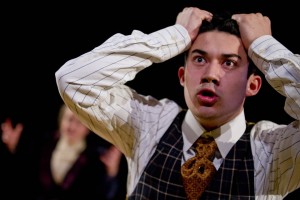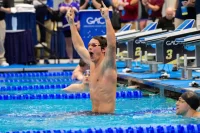
Play-within-a-play offers absurdist look at ‘Hedda Gabler’

From left, Colette Girardin ’16 of East Moriches, N.Y., plays Elizabeth Robins and Hanna Allerton ’15 of New York City portrays Marion Lea in the Bates production of “The Summer in Gossensass.” The performance is part of a senior thesis project for Allerton. (Phyllis Graber Jensen/Bates College)
Bates College presents The Summer in Gossensass, a meta-theatrical comedy about the first English-language production of Ibsen’s Hedda Gabler, in performances at 7:30 p.m. Thursday and Friday, Oct. 30-31, and Monday, Nov. 3; 5 p.m. Saturday, Nov. 1; and 2 p.m. Sunday, Nov. 2. The venue is Gannett Theater, Pettigrew Hall, 305 College St.
This play about creating a play was written by Maria Irene Fornes, and the Bates production is directed by Assistant Professor of Theater Brooke O’Harra. Admission is $6 for the general public and $3 for students and seniors, available at batestickets.com. For more information, please call 207-786-6161.
The play is inspired by a real moment in history. In the early 1890s, American actresses Elizabeth Robins and Marion Lea discovered the work of Norwegian playwright Henrik Ibsen and dedicated themselves to producing Hedda Gabler in English.

Brooke O’Harra, assistant professor of theater, directs “The Summer in Gossensass.” (Phyllis Graber Jensen/Bates College)
They were particularly fascinated with the complicated title character. Hedda Gabler, written in 1891, tells the story of a woman grappling for meaning and a sense of power within an unhappy marriage. The character of Hedda is one of the first complex and well-developed female characters in theater.
But where Hedda is seeking a path through her circumstances, the characters in Gossensass are seeking a path into the character of Hedda. Fornes’ play, says O’Harra, is meta-theatrical. “It’s an analysis of character in theater and what you do to embody a person.”
Fornes “is constantly using this historical moment to explore the process of analyzing a play — and the desire to make a play.”
Named for the place in Norway where Ibsen met the woman who inspired the Hedda character, Gossensass imagines how the collaboration between Robins and Lea may have unfolded. Throughout the play, the two discover, obsess over and struggle to produce Ibsen’s play. Much of the dialogue dwells on the nature of feminism in Hedda Gabler.
But the piece is also, O’Harra points out, “absurdist, so there’re all these crazy moments. It’s hilarious.” Enriching the comedy are complications involving the translation of the play, performance rights and interference from the Prince of Wales and his paramour Lillie Langtry.

Ciaran Walsh ’15 of Washington, D.C., performs in the 2014 Bates College production of “The Summer in Gossensass.” The performance is part of a senior thesis project for Walsh. (Phyllis Graber Jensen/Bates College)
The play’s meta-theatrical nature challenges the cast. If the characters are based on real people, each character at times also portrays a character from Hedda Gabler.
“It demands facile acting to even make the play intelligible to the audience,” says O’Harra. “When you read it on the page, the complexities of it are hard to understand. You have to do a good job acting for it to work.”
The production stars junior Colette Girardin of East Moriches, N.Y., as Robins and senior Hanna Allerton of New York City as Lea. The “acting inside of acting” that occurs throughout the play gives the students the opportunity to examine their own acting processes.
Also in the cast are senior Ciaran Walsh of Washington, D.C.; first-year Hope French of London; and sophomore Dan Peeples of Piermont, N.Y. For Allerton and Walsh, the production is the focus of their senior theses. Each will write a thesis detailing his or her acting process for the play and an analysis of the play itself.

Dan Peeples ’17 of Piermont, N.Y., portrays David in “The Summer in Gossensass.” (Phyllis Graber Jensen/Bates College)
The Summer in Gossensass, wrote The New York Times‘ Lawrence Van Gelder in a review of the play’s April 1998 debut, “is something of a comic valentine to the antediluvian avant-garde, a consideration of the evolution of acting styles and a trip back through time to a period when ideas about the psychological underpinnings of characters and those who play them constituted a thrilling novelty.”
Now 84, Fornes is an avant-garde Cuban-American playwright and director whom O’Harra describes as the mother of “downtown theater.” Winner of nine Obie awards, Fornes was a finalist for the Pulitzer Prize in 1990 with her play “And What of the Night?” She helped pave the way not only for experimental and absurdist theater, but also for female and Hispanic playwrights.
As a nod to the meta-theatrics of the play, O’Harra decided to cover the Gannett Theater stage floor with photocopies of the original Ibsen script.
“The play is constantly referring to itself,” she says. “It asks questions that you didn’t know you had. It forces you to see something beyond what you expect to see.”

![Sukanya Shukla Ô20 as Eurydice, Ethan Winglass Ô19 as Orpheus, Tim Dugan as Father, Cael Schwartz Ô19 as Man; Lord of Underworld, Madison Shmalo Ô19 as Little Stone, Jack Willis Ô19 Loud Stone, Lucas Allen Ô22 as Big Stone, perform during a dress rehearsal of Eurydice at Schaeffer Theater on October 31, 2018.
Eurydice by Sarah Ruhl
Directed by Dana Professor Martin Andrucki
Orpheus is a musical genius, Eurydice is his beautiful bride-to-be; but on the day of their wedding she dies suddenly. Heartbroken, Orpheus follows his beloved to the underworld, where his music persuades the lords of Hades to allow her to return to lifeÑon one condition. Discover what that is in this modern retelling of a classical myth by Sarah Ruhl, twice-nominated for the Pulitzer Prize in drama. ÒRhapsodically beautiful. . . [An] inexpressibly moving theatrical fable about love, loss and the pain of memory.ÓÑThe New York Times.
Please note: Box Office/Lobby for Eurydice is in The Black Box Theater at the rear of Schaeffer.
Thu, Nov 1, 7:30pm
Fri, Nov 2, 7:30
Sat. Nov 3, 5pm
Sun, Nov 4, 2pm
Mon, Nov 5, 7:30pm
Black Box Theater
DIRECTORÕS NOTE
Orpheus, the greatest musician who ever lived, married the beautiful Eurydice. She died on their wedding day, and descended into the Underworld. The grieving Orpheus followed her there, and by the beauty of his music persuaded the Lord of Hades to allow his bride to rejoin the living. It would be easy: Eurydice would simply follow Orpheus on the path back to life. However, there was one condition: if Orpheus looked behind him to assure that Eurydice was following, she would die againÑforever. He did look back; she did die again, forever; and Orpheus spent the rest of his life in mourning.
The classical version of this story focuses on Orpheus and his grief. Our playwright, Sarah Ruhl, puts Eurydice at the center of her drama, examining the crisis of a young woman who must choose between a romantic lover who doesnÕt understand her, and a dead father who does.
Lethe is one of five rivers in the Underworld. The newly dead are dipped in its water to wash away all their memories of life. It encircles the scene of our play.
PRODUCTION STAFF
Stage Manager; Sound Designer...........................................Deon Custard Ô21
Vocal Director......................................................................Katalin Vecsey Technical Director................................................................ Justin Moriarty
Assistant Technical Director..................................................Aidan McDowell Assistant Scenic Designer................................................Kirstin Koepnick Ô21 Assistant Lighting Designer.................................................Amiee Oakes Ô20 Assistant Stage Manager.....................................Luis David Molina Rueda Ô21 Costume Shop Supervisor... .....................................................Carol Farrell
Costume Shop Crew........................................Jade Zhang '21, Julia Nash '21 ............................Brooke Jandreau '20 Sara Hollenberg Õ19, Talia Sperduto '21 ...............................Jamie Kelleher Õ19, Sukanya Shukla Õ19, Kate Loughlin '22 Wardrobe........................................Brooke Jandreau Õ20, Sara Hollenberg '19 Foley Art.........................................................Henry King Ô22, Noah Pott Ô22 Light Board Operator..........................................................Aimee Oakes Ô20
Sound Board Operator............................................................Henry King Ô22
Carpenters...........................Quinn Healy '19, Haley Crim Õ19, Olivia Gomez '22 ...............................Julia Gutterman '20, Madison Hallowell '20, Henry King '22 .............Michael Hartnett '20, Julie Jesurum '22, Erin Lyons '21, Patrick Reilly '21 ........................Luis David Molina Rueda '20, Yilun Wu '22, Carlo Cremonini '21 ........Kei K. Ching Õ19, Kirstin Koepnick Ô21, Giulia Andronico de Morais Salles '22 ............................Deon Custard '21, Xavier Hayden '19, Gabriele Gucagaite '21 Animation......................................................Mayele Alognon Ô20, Sophie Gerry Ô20 ................................Daisy Diamond Ô19, Maddy Hallowell Ô20, Kirstin Koepnick Ô21 Run Crew..........................................Kei K. Ching Ô19, Gabriele Gucagaite Ô21
Box Office.....................................Alexandra Gilbertson '22, Georgia Moses Õ21 Poster Design............................................................................Lily Kip Ô19 Social Media ..............................................David Garcia Ô20, Nicky Longo Ô21 Custodians......................................................Hussein Kulow, Ed Woodhead
Special Thanks to: John Blanche e; John Corrie](https://www.bates.edu/news/files/2018/11/181031_Eurydice_2870-200x133.jpg)


